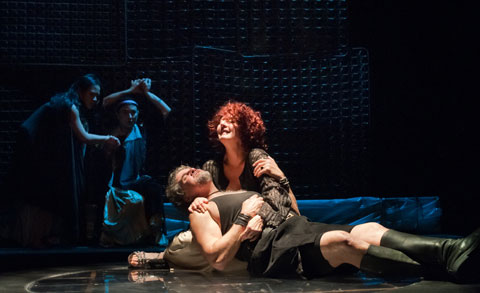
NO RAVISHING EXCESS But Paula Plum does love James Andreassi, especially once he’s dead. |
In Antony and Cleopatra, the Brangelina of the ancient world are transported from messy, histrionic life to the realm of legend. Audiences at Actors' Shakespeare Project's streamlined, slightly rearranged presentation of the play are less likely to be transported. Neither the production (at the Modern Theatre through May 21) nor the performances achieve the ravishing excess for which this gorgeously poetic script — a mix of history and tragedy — cries out. Beloved local diva Paula Plum, though playful and commanding, lacks the "infinite variety" the Bard ascribes to his "serpent of old Nile." James Andreassi is a gruff, rugged Antony, but his "captain's heart" seems broken from the get-go. Each has thrilling moments, but they don't add up to enough to justify a staging that eliminates much of the political business of the play to concentrate on them and then reduces their epic if theatrical love to spanking games.
Then again, it may be me. I have seen three productions of Antony and Cleopatra — at Boston Theater Works, at Shakespeare & Company, and this one — in the past eight years, and I've never swooned the way I do reading the script, especially the long, slow flame-out of the fourth and fifth acts, which ASP director Adrianne Krstansky, though she cuts the play to a little over two hours, leaves intact. No Joseph L. Mankiewicz, she eliminates the expensive pageantry and radically trims the Bard's roster of more than 30 characters. (The excisions include Pompey and the pirates.) Nine actors, most juggling several roles, portray those that remain. Similarly, the jockeying warfare of the play, which jumps all around "the rang'd empire," is whittled here to the essential struggle between the waning Antony, with his unhelpful paramour, and the younger, more cold-blooded Octavius Caesar.
Despite its not being opulent, the production benefits from John Lee Beatty's dried-blood-colored murals for Suffolk University's newly renovated Modern Theatre. And in Jeff Adelberg's design, the action is set against a backdrop of coiled, gilded frames that may be mattress springs. Both Adelberg's lighting and David Remedios's clanging sound emphasize the contrast between the indolent East, where Antony's pleasure lies, and the harsher West that summons him to duties both martial and marital. Anna-Alisa Belous's costumes are a mixed bag, particularly for Plum, the best being a cream-and-gold ensemble that makes her look both exotic and regal. In others, with her bottle-red curls, she resembles a Tennessee Williams floozy in a gauzy wrapper. And whereas Doug Lockwood's impassive Octavius and Richard Snee's ironic Enobarbus look like Romans, Andreassi's one-shouldered tunic and tattered cape turn him into one of the Flintstones. I know the guy's gone to sex and seed, but, really.
A savvy player, Plum obviously understands that her character is a self-made work of dramatic art. Still, in the early scenes, she sometimes settles for petulant or acerb. But if her Cleopatra spends part of the play being as enamored of her own bewitchments as she is of Antony (and is a firecracker when he betrays her), she truly loves him once he's dead. Her act-five queen brims with genuine grief. And I love the way that, having applied and nursed her asp, this Cleopatra does not collapse against death's door but instead strides silently off and into legend, leaving her women to tend an invisible corpse.